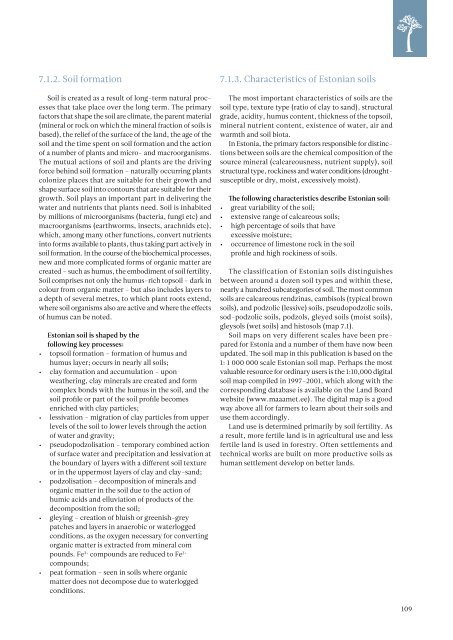ESTONIAN ENVIRONMENTAL REVIEW 2009
ESTONIAN ENVIRONMENTAL REVIEW 2009
ESTONIAN ENVIRONMENTAL REVIEW 2009
You also want an ePaper? Increase the reach of your titles
YUMPU automatically turns print PDFs into web optimized ePapers that Google loves.
7.1.2. Soil formation<br />
Soil is created as a result of long-term natural processes<br />
that take place over the long term. The primary<br />
factors that shape the soil are climate, the parent material<br />
(mineral or rock on which the mineral fraction of soils is<br />
based), the relief of the surface of the land, the age of the<br />
soil and the time spent on soil formation and the action<br />
of a number of plants and micro- and macroorganisms.<br />
The mutual actions of soil and plants are the driving<br />
force behind soil formation – naturally occurring plants<br />
colonize places that are suitable for their growth and<br />
shape surface soil into contours that are suitable for their<br />
growth. Soil plays an important part in delivering the<br />
water and nutrients that plants need. Soil is inhabited<br />
by millions of microorganisms (bacteria, fungi etc) and<br />
macroorganisms (earthworms, insects, arachnids etc),<br />
which, among many other functions, convert nutrients<br />
into forms available to plants, thus taking part actively in<br />
soil formation. In the course of the biochemical processes,<br />
new and more complicated forms of organic matter are<br />
created – such as humus, the embodiment of soil fertility.<br />
Soil comprises not only the humus-rich topsoil – dark in<br />
colour from organic matter – but also includes layers to<br />
a depth of several metres, to which plant roots extend,<br />
where soil organisms also are active and where the effects<br />
of humus can be noted.<br />
Estonian soil is shaped by the<br />
following key processes:<br />
• topsoil formation – formation of humus and<br />
humus layer; occurs in nearly all soils;<br />
• clay formation and accumulation – upon<br />
weathering, clay minerals are created and form<br />
complex bonds with the humus in the soil, and the<br />
soil profile or part of the soil profile becomes<br />
enriched with clay particles;<br />
• lessivation – migration of clay particles from upper<br />
levels of the soil to lower levels through the action<br />
of water and gravity;<br />
• pseudopodzolisation – temporary combined action<br />
of surface water and precipitation and lessivation at<br />
the boundary of layers with a different soil texture<br />
or in the uppermost layers of clay and clay-sand;<br />
• podzolisation – decomposition of minerals and<br />
organic matter in the soil due to the action of<br />
humic acids and elluviation of products of the<br />
decomposition from the soil;<br />
• gleying – creation of bluish or greenish-grey<br />
patches and layers in anaerobic or waterlogged<br />
conditions, as the oxygen necessary for converting<br />
organic matter is extracted from mineral com<br />
pounds. Fe 3+ compounds are reduced to Fe 2+<br />
compounds;<br />
• peat formation – seen in soils where organic<br />
matter does not decompose due to waterlogged<br />
conditions.<br />
7.1.3. Characteristics of Estonian soils<br />
The most important characteristics of soils are the<br />
soil type, texture type (ratio of clay to sand), structural<br />
grade, acidity, humus content, thickness of the topsoil,<br />
mineral nutrient content, existence of water, air and<br />
warmth and soil biota.<br />
In Estonia, the primary factors responsible for distinctions<br />
between soils are the chemical composition of the<br />
source mineral (calcareousness, nutrient supply), soil<br />
structural type, rockiness and water conditions (droughtsusceptible<br />
or dry, moist, excessively moist).<br />
The following characteristics describe Estonian soil:<br />
• great variability of the soil;<br />
• extensive range of calcareous soils;<br />
• high percentage of soils that have<br />
excessive moisture;<br />
• occurrence of limestone rock in the soil<br />
profile and high rockiness of soils.<br />
The classification of Estonian soils distinguishes<br />
between around a dozen soil types and within these,<br />
nearly a hundred subcategories of soil. The most common<br />
soils are calcareous rendzinas, cambisols (typical brown<br />
soils), and podzolic (lessive) soils, pseudopodzolic soils,<br />
sod-podzolic soils, podzols, gleyed soils (moist soils),<br />
gleysols (wet soils) and histosols (map 7.1).<br />
Soil maps on very different scales have been prepared<br />
for Estonia and a number of them have now been<br />
updated. The soil map in this publication is based on the<br />
1: 1 000 000 scale Estonian soil map. Perhaps the most<br />
valuable resource for ordinary users is the 1:10,000 digital<br />
soil map compiled in 1997–2001, which along with the<br />
corresponding database is available on the Land Board<br />
website (www.maaamet.ee). The digital map is a good<br />
way above all for farmers to learn about their soils and<br />
use them accordingly.<br />
Land use is determined primarily by soil fertility. As<br />
a result, more fertile land is in agricultural use and less<br />
fertile land is used in forestry. Often settlements and<br />
technical works are built on more productive soils as<br />
human settlement develop on better lands.<br />
109

















